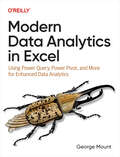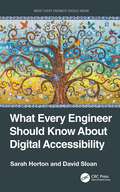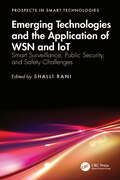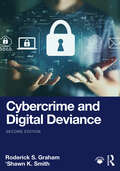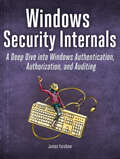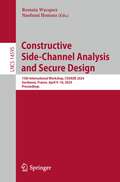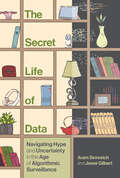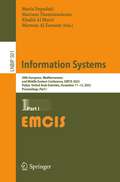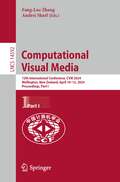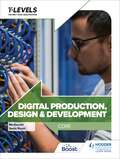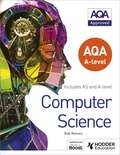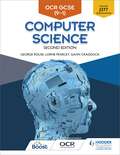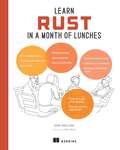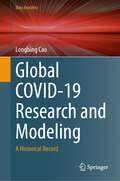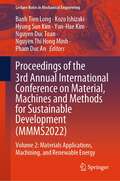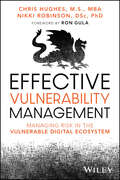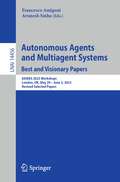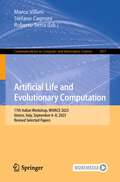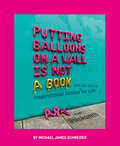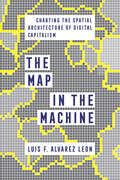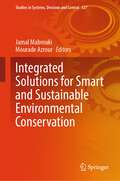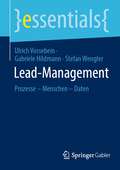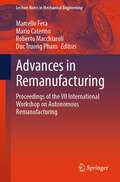- Table View
- List View
Modern Data Analytics in Excel: Using Power Query, Power Pivot, And More For Enhanced Data Analytics
by George MountIf you haven't modernized your data cleaning and reporting processes in Microsoft Excel, you're missing out on big productivity gains. And if you're looking to conduct rigorous data analysis, more can be done in Excel than you think. This practical book serves as an introduction to the modern Excel suite of features along with other powerful tools for analytics.George Mount of Stringfest Analytics shows business analysts, data analysts, and business intelligence specialists how to make bigger gains right from your spreadsheets by using Excel's latest features. You'll learn how to build repeatable data cleaning workflows with Power Query, and design relational data models straight from your workbook with Power Pivot. You'll also explore other exciting new features for analytics, such as dynamic array functions, AI-powered insights, and Python integration.Learn how to build reports and analyses that were previously difficult or impossible to do in Excel. This book shows you how to:Build repeatable data cleaning processes for Excel with Power QueryCreate relational data models and analysis measures with Power PivotPull data quickly with dynamic arraysUse AI to uncover patterns and trends from inside ExcelIntegrate Python functionality with Excel for automated analysis and reporting
What Every Engineer Should Know About Digital Accessibility (ISSN)
by Sarah Horton David SloanAccessibility is a core quality of digital products to be deliberately addressed throughout the development lifecycle. What Every Engineer Should Know About Digital Accessibility will prepare readers to integrate digital accessibility into their engineering practices. Readers will learn how to accurately frame accessibility as an engineering challenge so they are able to address the correct problems in the correct way.Illustrated with diverse perspectives from accessibility practitioners and advocates, this book describes how people with disabilities use technology, the nature of accessibility barriers in the digital world, and the role of engineers in breaking down those barriers. Accessibility competence for current, emerging, and future technologies is addressed through a combination of guiding principles, core attributes and requirements, and accessibility‑informed engineering practices.FEATURES Discusses how technology can support inclusion for people with disabilities and how rigorous engineering processes help create quality user experiences without introducing accessibility barriers Explains foundational principles and guidelines that build core competency in digital accessibility as they are applied across diverse and emerging technology platforms Highlights practical insights into how engineering teams can effectively address accessibility throughout the technology development lifecycle Uses international standards to define and measure accessibility quality Written to be accessible to non‑experts in the subject area, What Every Engineer Should Know About Digital Accessibility is aimed at students, professionals, and researchers in the field of software engineering.
Emerging Technologies and the Application of WSN and IoT: Smart Surveillance, Public Security, and Safety Challenges (Prospects in Smart Technologies)
by Shalli RaniThe Internet of Things (IoT) has numerous applications, including smart cities, industries, cloud-based apps, smart homes, and surveillance.The Internet of Things (IoT) enables smarter living by connecting devices, people, and objects. As networking became a crucial aspect of the Internet, rigorous design analysis led to the development of new research areas.The Internet of Things has revolutionized daily living in countless ways. It enables communication between buildings, people, portable gadgets, and vehicles, facilitating mobility. Smart cities and cloud-based data have transformed corporate practices. With billions of connected gadgets, everything will soon be able to communicate remotely. IoT networks, whether public or private, rely significantly on machine learning and software-defined networking. Indian and other governments have approved various research projects on IoT-based networking technologies. This field of study will significantly impact society in the future.Researchers are concerned about the many application areas and driving forces behind smart cities. The authors aim to provide insights into software-defined networking, artificial intelligence, and machine learning technologies used in IoT and networking. The framework focuses on practical applications and infrastructures. The book includes practical challenges, case studies, innovative concepts, and other factors that impact the development of realistic scenarios for smart surveillance. It also highlights innovative technology, designs, and algorithms that can accelerate the creation of smart city concepts.This resource includes real-world applications and case studies for smart city technology, enormous data management, and machine learning prediction, all with confidentiality and safety problems.
Cybercrime and Digital Deviance
by Roderick S. Graham 'Shawn K. SmithCybercrime and Digital Deviance, Second Edition, combines insights from sociology, criminology, psychology, and cybersecurity to explore cybercrimes such as hacking, identity theft, and romance scams, along with forms of digital deviance such as pornography addiction, trolling, and “canceling” people for perceived violations of norms.Other issues are explored including cybercrime investigations, nation-state cybercrime, the use of algorithms in policing, cybervictimization, and expanded discussion of the theories used to explain cybercrime. Graham and Smith conceptualize the online space as a distinct environment for social interaction, framing their work with assumptions informed by their respective work in urban sociology and spatial criminology, and offering an engaging entry point for understanding what may appear to be a technologically complex course of study. The authors apply a modified version of a typology developed by David Wall: cybertrespass, cyberfraud, cyberviolence, and cyberpornography. This typology is simple enough for students just beginning their inquiry into cybercrime, while its use of legal categories of trespassing, fraud, violent crimes against persons, and moral transgressions provides a solid foundation for deeper study. In this edition each chapter includes a new “Current Events and Critical Thinking” section, using concepts from the chapter to explore a specific event or topic like the effect of disinformation on social cohesion and politics.Taken together, Graham and Smith’s application of a digital environment and Wall’s cybercrime typology makes this an ideal upper-level text for students in sociology and criminal justice. It is also an ideal introductory text for students within the emerging disciplines of cybercrime and cybersecurity.
Windows Security Internals: A Deep Dive into Windows Authentication, Authorization, and Auditing
by James ForshawPower up your Windows security skills with expert guidance, in-depth technical insights, and dozens of real-world vulnerability examples from Google Project Zero&’s most renowned researcher! Learn core components of the system in greater depth than ever before, and gain hands-on experience probing advanced Microsoft security systems with the added benefit of PowerShell scripts.Windows Security Internals is a must-have for anyone needing to understand the Windows operating system&’s low-level implementations, whether to discover new vulnerabilities or protect against known ones. Developers, devops, and security researchers will all find unparalleled insight into the operating system&’s key elements and weaknesses, surpassing even Microsoft&’s official documentation.Author James Forshaw teaches through meticulously crafted PowerShell examples that can be experimented with and modified, covering everything from basic resource security analysis to advanced techniques like using network authentication. The examples will help you actively test and manipulate system behaviors, learn how Windows secures files and the registry, re-create from scratch how the system grants access to a resource, learn how Windows implements authentication both locally and over a network, and much more.You&’ll also explore a wide range of topics, such as:Windows security architecture, including both the kernel and user-mode applicationsThe Windows Security Reference Monitor (SRM), including access tokens, querying and setting a resource&’s security descriptor, and access checking and auditingInteractive Windows authentication and credential storage in the Security Account Manager (SAM) and Active DirectoryMechanisms of network authentication protocols, including NTLM and KerberosIn an era of sophisticated cyberattacks on Windows networks, mastering the operating system&’s complex security mechanisms is more crucial than ever. Whether you&’re defending against the latest cyber threats or delving into the intricacies of Windows security architecture, you&’ll find Windows Security Internals indispensable in your efforts to navigate the complexities of today&’s cybersecurity landscape.
Constructive Side-Channel Analysis and Secure Design: 15th International Workshop, COSADE 2024, Gardanne, France, April 9–10, 2024, Proceedings (Lecture Notes in Computer Science #14595)
by Romain WacquezThis book constitutes the refereed proceedings of the 15th International Workshop on Constructive Side-Channel Analysis and Secure Design, COSADE 2024, held in Gardanne, France, during April 9–10, 2024. The 14 full papers included in this book were carefully reviewed and selected from 42 submissions. They were organized in topical sections as follows: Analyses and Tools; Attack Methods; Deep-Learning-Based Side-Channel Attacks; PUF/RNG; and Cryptographic Implementations.
The Secret Life of Data: Navigating Hype and Uncertainty in the Age of Algorithmic Surveillance (The Information Society Series)
by Aram Sinnreich Jesse GilbertHow data surveillance, digital forensics, and generative AI pose new long-term threats and opportunities—and how we can use them to make better decisions in the face of technological uncertainty.In The Secret Life of Data, Aram Sinnreich and Jesse Gilbert explore the many unpredictable, and often surprising, ways in which data surveillance, AI, and the constant presence of algorithms impact our culture and society in the age of global networks. The authors build on this basic premise: no matter what form data takes, and what purpose we think it&’s being used for, data will always have a secret life. How this data will be used, by other people in other times and places, has profound implications for every aspect of our lives—from our intimate relationships to our professional lives to our political systems.With the secret uses of data in mind, Sinnreich and Gilbert interview dozens of experts to explore a broad range of scenarios and contexts—from the playful to the profound to the problematic. Unlike most books about data and society that focus on the short-term effects of our immense data usage, The Secret Life of Data focuses primarily on the long-term consequences of humanity&’s recent rush toward digitizing, storing, and analyzing every piece of data about ourselves and the world we live in. The authors advocate for &“slow fixes&” regarding our relationship to data, such as creating new laws and regulations, ethics and aesthetics, and models of production for our data-fied society.Cutting through the hype and hopelessness that so often inform discussions of data and society, The Secret Life of Data clearly and straightforwardly demonstrates how readers can play an active part in shaping how digital technology influences their lives and the world at large.
Information Systems: 20th European, Mediterranean, and Middle Eastern Conference, EMCIS 2023, Dubai, United Arab Emirates, December 11-12, 2023, Proceedings, Part I (Lecture Notes in Business Information Processing #501)
by Maria Papadaki Marinos Themistocleous Khalid Al Marri Marwan Al ZarouniThis book constitutes selected papers from the 20th European, Mediterranean, and Middle Eastern Conference, EMCIS 2023, which was held in Dubai, UAE, during December 11-12, 2023. EMCIS covers technical, organizational, business, and social issues in the application of information technology and is dedicated to the definition and establishment of Information Systems (IS) as a discipline of high impact for IS professionals and practitioners. It focuses on approaches that facilitate the identification of innovative research of significant relevance to the IS discipline following sound research methodologies that lead to results of measurable impact. The 43 papers presented in this volume were carefully reviewed and selected from a total of 126 submissions. They were organized in topical sections as follows: Part I: Metaverse; blockchain technology and applications; digital governance; healthcare information systems; artificial intelligence; Part II: Big data and analytics; digital services and social media; innovative research projects; managing information systems; smart cities.
Computational Visual Media: 12th International Conference, CVM 2024, Wellington, New Zealand, April 10–12, 2024, Proceedings, Part I (Lecture Notes in Computer Science #14592)
by Fang-Lue Zhang Andrei SharfThis book constitutes the refereed proceedings of CVM 2024, the 12th International Conference on Computational Visual Media, held in Wellington, New Zealand, in April 2024.The 34 full papers were carefully reviewed and selected from 212 submissions. The papers are organized in topical sections as follows:Part I: Reconstruction and Modelling, Point Cloud, Rendering and Animation, User Interations.Part II: Facial Images, Image Generation and Enhancement, Image Understanding, Stylization, Vision Meets Graphics.
Digital Production, Design and Development T Level: Core
by Sonia Stuart Maureen EverettTackle the core component of the Digital Production, Design and Development T Level with this comprehensive resource.Written by highly respected authors, Mo Everett and Sonia Stuart, this clear, accessible and thorough textbook will guide learners through the key principles, concepts and terminology, as well as providing the inside track into what it takes to kick-start a career in the Digital world.- Simplify complex topics with summary tables, diagrams, key term definitions and a glossary.- Track and strengthen knowledge by using learning outcomes at the beginning of every unit and 'Test Yourself' questions.- Apply knowledge and understanding across 100s of engaging activities and research tasks.- Prepare for exams and the employer-set project using practice questions and project practice exercises.- Get ready for the workplace with industry tips and real-world examples.- Be guided through the course by expert authors Mo Everett and Sonia Stuart, who draw on their extensive industry and teaching experience.
AQA A level Computer Science
by Bob ReevesExam Board: AQALevel: AS/A-levelSubject: Computer ScienceFirst Teaching: September 2015First Exam: June 2016This title has been approved by AQA for use with the AS and A-level AQA Computer Science specifications. AQA A-level Computer Science gives students the chance to think creatively and progress through the AQA AS and A-level Computer Science specifications. Detailed coverage of the specifications will enrich understanding of the fundamental principles of computing, whilst a range of activities help to develop the programming skills and computational thinking skills at A-level and beyond. - Enables students to build a thorough understanding of the fundamental principles in the AQA AS and A-Level Computer Science specifications, with detailed coverage of programming, algorithms, data structures and representation, systems, databases and networks, uses and consequences.- Helps to tackle the various demands of the course confidently, with advice and support for programming and theoretical assessments and the problem-solving or investigative project at A-level.- Develops the programming and computational thinking skills for A-level and beyond - frequent coding and question practice will help students apply their knowledge of the principles of computer science, and design, program and evaluate problem-solving computer systems. Bob Reeves is an experienced teacher with examining experience, and well-respected author of resources for Computing and ICT across the curriculum.
OCR GCSE Computer Science, Second Edition
by George Rouse Lorne Pearcey Gavin Craddock Ian PagetWritten by leading Computer Science teachers, this brand-new textbook will guide students through the updated OCR GCSE Computer Science specification topic by topic, and provide them with standalone recap and review sections, worked examples and clear explanations of complex topics.This Student Book:>> develops computational thinking skills in line with the new Practical Programming element of Component 02>> provides differentiated material with the 'beyond the spec' feature>> includes standalone recap and review sections at the end of each chapter>> includes answers to the Knowledge Check questions to support independent learning>> provides definitions of technical terms, along with a glossary of words that will be needed for assessment.Looking for answers for the Student Book? They can be found at the back of the print textbook.You can now access a free set of practice questions on the Hodder Education website. Please note, these questions are not endorsed by OCR and have not been subject to any OCR quality assurance processes.George Rouse, Lorne Pearcey and Gavin Craddock are highly respected and widely published authors of resources.
Learn Rust in a Month of Lunches (In a Month of Lunches)
by David MacLeodOne month. One hour a day. That&’s all it takes to start writing Rust code!Learn Rust in a Month of Lunches teaches you to write super fast and super safe Rust code through lessons you can fit in your lunch break. Crystal-clear explanations and focused, relevant examples make it accessible to anyone—even if you&’re learning Rust as your first programming language. By the time you&’re done reading Learn Rust in a Month of Lunches you&’ll be able to: Build real software in Rust Understand messages from the compiler and Clippy, Rust&’s coding coach Make informed decisions on the right types to use in any context Make sense of the Rust standard library and its commonly used items Use external Rust &“crates&” (libraries) for common tasks Comment and build documentation for your Rust code Work with crates that use async Rust Write simple declarative macros Explore test driven development in Rust Learn Rust in a Month of Lunches is full of 24 easy-to-digest lessons that ease you into real Rust programming. You&’ll learn essential Rust skills you can use for everything from system programming, to web applications, and games. By the time you&’re done learning, you&’ll know exactly what makes Rust unique—and be one of the thousands of developers who say it&’s their best loved language! About the technology Learn how to create fast powerful programs in Rust in just 24 short lessons! Rust gives you modern features like a top-notch compiler, a rich ecosystem of pre-built libraries, and the same low-level performance you get with a language like C, but without the awkward syntax, complex memory management, and code safety concerns. This book guides you step by step from your first line of code. About the book Learn Rust in a Month of Lunches breaks down the Rust language into concise hands-on lessons designed to be completed in an hour or less. The examples are fun and easy to follow, so you&’ll quickly progress from zero Rust knowledge to handling async and writing your own macros. You won&’t even need to install Rust—the book&’s code samples run in the browser-based Rust Playground. There&’s no easier way to get started! What's inside Build working Rust software Understand messages from the compiler and Clippy Use external Rust &“crates&” (libraries) for common tasks Explore test driven development in Rust About the reader No previous experience with Rust required. About the author Dave MacLeod was an educator, Korean-English translator, project controller, and copywriter before becoming a full-time Rust developer. The technical editor on this book was Jerry Kuch. Table of Contents 1 Some basics 2 Memory, variables, and ownership 3 More complex types 4 Building your own types 5 Generics, option, and result 6 More collections, more error handling 7 Traits: Making different types do the same thing 8 Iterators and closures 9 Iterators and closures again! 10 Lifetimes and interior mutability 11 Multiple threads and a lot more 12 More on closures, generics, and threads 13 Box and Rust documentation 14 Testing and building your code from tests 15 Default, the builder pattern, and Deref 16 Const, &“unsafe&” Rust, and external crates 17 Rust&’s most popular crates 18 Rust on your computer 19 More crates and async Rust 20 A tour of the standard library 21 Continuing the tour 22 Writing your own macros 23 Unfinished projects: Projects for you to finish 24 Unfinished projects, continued
Global COVID-19 Research and Modeling: A Historical Record (Data Analytics)
by Longbing CaoThis book provides answers to fundamental and challenging questions regarding the global response to COVID-19. It creates a historical record of COVID-19 research conducted over the four years of the pandemic, with a focus on how researchers have responded, quantified, and modeled COVID-19 problems. Since mid-2021, we have diligently monitored and analyzed global scientific efforts in tackling COVID-19. Our comprehensive global endeavor involves collecting, processing, analyzing, and discovering COVID-19 related scientific literature in English since January 2020. This provides insights into how scientists across disciplines and almost every country and regions have fought against COVID-19. Additionally, we explore the quantification of COVID-19 problems and impacts through mathematics, AI, machine learning, data science, epidemiology, and domain knowledge. The book reports findings on publication quantities, impacts, collaborations, and correlations with the economy and infectionsglobally, regionally, and country-wide. These results represent the first and only holistic and systematic studies aimed at scientifically understanding, quantifying, and containing the pandemic. We hope this comprehensive analysis will contribute to better preparedness, response, and management of future emergencies and inspire further research in infectious diseases. The book also serves as a valuable resource for research policy, funding management authorities, researchers, policy makers, and funding bodies involved in infectious disease management, public health, and emergency resilience.
Social Media für Introvertierte: Erfolgreich sichtbar als leiser Unternehmer
by Tanja BernsauDieses Buch richtet sich an introvertierte Selbstständige, Solopreneure und Unternehmer und zeigt auf, wie sie Social Media auf die eigene, leise Art für Vertrieb und Marketing zu ihrem Vorteil nutzen können. Denn: Introvertierte Menschen haben zahlreiche verborgene Stärken, die ihnen besonders im Verkauf zugute kommen können. Diese gilt es zu entfalten!Die Autorin, selbst ein „leiser“ Mensch, räumt mit Mythen und Vorurteilen auf, präsentiert eine Vielzahl von praktischen Orientierungshilfen und Strategien für eine wirksame Positionierung auf Social Media. Am Beispiel der für Unternehmer wichtigsten Plattform LinkedIn zeigt sie auf, wie u. a. Social Selling, Social Listening, Content Marketing oder Personal Branding funktionieren – und mit welchen Kniffen sich introvertierte Menschen selbst aus dem Schneckenhaus locken.
Proceedings of the 3rd Annual International Conference on Material, Machines and Methods for Sustainable Development: Volume 2: Materials Applications, Machining, and Renewable Energy (Lecture Notes in Mechanical Engineering)
by Banh Tien Long Kozo Ishizaki Hyung Sun Kim Yun-Hae Kim Nguyen Duc Toan Nguyen Thi Hong Minh Pham Duc AnThis book presents selected, peer-reviewed proceedings of the 3rd International Conference on Material, Machines and Methods for Sustainable Development (MMMS2022), held in the city of Can Tho, Vietnam, from 10 to 13 November 2022. The purpose of the conference is to explore and ensure an understanding of the critical aspects contributing to sustainable development with a focus on advanced mechanical engineering, automation, materials, machines and methods. The contributions published in this book come from authors representing universities, research institutes and industrial companies and reflect the results of a very broad spectrum of research, from micro- and nanoscale materials design and processing, to mechanical engineering technology in industry. Many of the contributions selected for these proceedings focus on materials modeling, eco-material processes and mechanical manufacturing. Volume 2 of this book focuses on topics dedicated to materials applications, machining, and renewable energy. Selected topics include: material machinability and economic efficiency, sustainable development manufacturing technology, environmental protection, as well as green development and climate change prevention.
Effective Vulnerability Management: Managing Risk in the Vulnerable Digital Ecosystem
by Chris Hughes Nikki RobinsonInfuse efficiency into risk mitigation practices by optimizing resource use with the latest best practices in vulnerability management Organizations spend tremendous time and resources addressing vulnerabilities to their technology, software, and organizations. But are those time and resources well spent? Often, the answer is no, because we rely on outdated practices and inefficient, scattershot approaches. Effective Vulnerability Management takes a fresh look at a core component of cybersecurity, revealing the practices, processes, and tools that can enable today's organizations to mitigate risk efficiently and expediently in the era of Cloud, DevSecOps and Zero Trust. Every organization now relies on third-party software and services, ever-changing cloud technologies, and business practices that introduce tremendous potential for risk, requiring constant vigilance. It's more crucial than ever for organizations to successfully minimize the risk to the rest of the organization's success. This book describes the assessment, planning, monitoring, and resource allocation tasks each company must undertake for successful vulnerability management. And it enables readers to do away with unnecessary steps, streamlining the process of securing organizational data and operations. It also covers key emerging domains such as software supply chain security and human factors in cybersecurity. Learn the important difference between asset management, patch management, and vulnerability management and how they need to function cohesively Build a real-time understanding of risk through secure configuration and continuous monitoring Implement best practices like vulnerability scoring, prioritization and design interactions to reduce risks from human psychology and behaviors Discover new types of attacks like vulnerability chaining, and find out how to secure your assets against them Effective Vulnerability Management is a new and essential volume for executives, risk program leaders, engineers, systems administrators, and anyone involved in managing systems and software in our modern digitally-driven society.
Autonomous Agents and Multiagent Systems. Best and Visionary Papers: AAMAS 2023 Workshops, London, UK, May 29 –June 2, 2023, Revised Selected Papers (Lecture Notes in Computer Science #14456)
by Francesco Amigoni Arunesh SinhaThis book contains visionary and best papers from the workshops held at the International Conference on Autonomous Agents and Multiagent Systems, AAMAS 2023, held in London, UK, during May 29–June 2, 2023.The 12 regular papers, 5 best papers and 7 visionary papers, presented were carefully reviewed and selected from a total of more than 110 contributions to the workshops. They focus on emerging topics and new trends in the area of autonomous agents and multiagent systems and stem from the following workshops:- Workshop on Autonomous Robots and Multirobot Systems (ARMS)- Workshop on Adaptive and Learning Agents (ALA)- Workshop on Interdisciplinary Design of Emotion Sensitive Agents (IDEA)- Workshop on Rebellion and Disobedience in Artificial Intelligence (RaD-AI)- Workshop on Neuro-symbolic AI for Agent and Multi-Agent Systems (NeSyMAS)- Workshop on Multiagent Sequential Decision Making under Uncertainty (MSDM)- Workshop on Citizen-Centric Multi-Agent Systems (C-MAS)
Artificial Life and Evolutionary Computation: 17th Italian Workshop, WIVACE 2023, Venice, Italy, September 6–8, 2023, Revised Selected Papers (Communications in Computer and Information Science #1977)
by Marco Villani Stefano Cagnoni Roberto SerraThis book constitutes the refereed post proceedings of the 17th Italian Workshop on Artificial Life and Evolutionary Computation, WIVACE 2023, held in Venice, Italy, during September 6–8, 2023.The 30 full papers included in this book were carefully reviewed and selected from 55 submissions. They were organized in topical sections as follows: Algorithms for complex systems, Biologically inspired models, Complex chemical systems, Adaptation and swarms, Learning, Medicine and Social systems.
Putting Balloons on a Wall Is Not a Book: Inspirational Advice (and Non-Advice) for Life from @blcksmth
by Michael James SchneiderFrom viral balloon-word artist and Instagram sensation Michael James Schneider (@blcksmth) comes a one-of-a-kind debut gift book with never-before-seen original artwork!Featuring many of @blcksmth&’s most iconic balloon, flower, and light installations—plus exclusive new content—this book has a little something for everyone. Filled with funny, inspiring, and heartwarming messages on topics like self-love, self-growth, self-doubt, and advice for your future self, this is the perfect gift for any occasion or reader.
The Map in the Machine: Charting the Spatial Architecture of Digital Capitalism
by Luis F. Alvarez LeonDigital technologies have changed how we shop, work, play, and communicate, reshaping our societies and economies. To understand digital capitalism, we need to grasp how advances in geospatial technologies underpin the construction, operation, and refinement of markets for digital goods and services. In The Map in the Machine, Luis F. Alvarez Leon examines these advances, from MapQuest and Google Maps to the rise of IP geolocation, ridesharing, and a new Earth Observation satellite ecosystem. He develops a geographical theory of digital capitalism centered on the processes of location, valuation, and marketization to provide a new vantage point from which to better understand, and intervene in, the dominant techno-economic paradigm of our time. By centering the spatiality of digital capitalism, Alvarez Leon shows how this system is the product not of seemingly intangible information clouds but rather of a vast array of technologies, practices, and infrastructures deeply rooted in place, mediated by geography, and open to contestation and change.
Appreciation Post: Towards an Art History of Instagram
by Tara WardWhat does an art history of Instagram look like? Appreciation Post reveals how Instagram shifts long-established ways of interacting with images. Tara Ward argues Instagram is a structure of the visual, which includes not just the process of looking, but what can be seen and by whom. She examines features of Instagram use, including the effect of scrolling through images on a phone, the skill involved in taking an "Instagram-worthy" picture, and the desires created by following influencers, to explain how the constraints imposed by Instagram limit the selves that can be displayed on it. The proliferation of technical knowledge, especially among younger women, revitalizes on Instagram the myth of the masculine genius and a corresponding reinvigoration of a masculine audience for art. Ward prompts scholars of art history, gender studies, and media studies to attend to Instagram as a site of visual expression and social consequence. Through its insightful comparative analysis and acute close reading, Appreciation Post argues for art history’s value in understanding the contemporary world and the visual nature of identity today.
Integrated Solutions for Smart and Sustainable Environmental Conservation (Studies in Systems, Decision and Control #527)
by Jamal Mabrouki Mourade AzrourResource depletion and ecological risks are more than ever at the heart of societal and economic debates. In the 1970s, the developed countries saw the Fordist growth regime crumble in parallel with the growing awareness of the ecological issue. Since the first industrial revolutions, technological dynamics have been the cause of many environmental problems, and there is a consensus on the diagnosis. Integrated technologies reduce resource use and/or pollution at source by using cleaner production methods. This generally leads to a reduction in the by-products, energy inputs and resources used by companies to produce goods. Integrated production technologies reduce negative environmental impacts at source by substituting or modifying cleaner technologies. Examples of integrated, or cleaner, production technologies are the recirculation of materials, the use of environmentally friendly materials (such as the substitution of water for organic solvents), etc. However, the implementation of integrated production technologies is often hampered by obstacles related to cost, coordination and skill inertia problems and to the productive organisation of companies. In addition to the high investment costs of new integrated technologies, additional barriers may emerge depending on the nature of the environmental problem and the type of environmental regulation in question.
Lead-Management: Prozesse – Menschen – Daten (essentials)
by Ulrich Vossebein Gabriele Hildmann Stefan WenglerLead-Management ist eine der großen Herausforderungen im Vertrieb, da die Neukundengewinnung immer bedeutsamer wird. Dieses essential erläutert, wie durch den parallelen Ausbau der drei Basisdimensionen: Prozesse, Menschen und Daten Lead-Exzellenz erreicht werden kann. Hierzu sind zunächst die Rahmenbedingungen zu analysieren und zu bewerten. Anschließend müssen die Prozesse in eine Prozesslandkarte eingebunden, die Kompetenzprofile den neuen Anforderungen angepasst und die Datenbasis vervollständigt werden. Eine umfangreiche Checkliste zeigt auf, wie Unternehmen bei der Einführung oder Überarbeitung ihres bereits existierenden Lead-Managements sinnvollerweise vorgehen sollten.
Advances in Remanufacturing: Proceedings of the VII International Workshop on Autonomous Remanufacturing (Lecture Notes in Mechanical Engineering)
by Marcello Fera Mario Caterino Roberto Macchiaroli Duc Truong PhamThis book features the papers presented at IWAR 2023. The overall objective of the event was to bring together international scientists and engineers to bridge the academic and industrial worlds in the field of remanufacturing. Various themes related to remanufacturing, including methods for operations management, methodologies for quality assessment and life cycle assessment, the integration of robots in remanufacturing, and the use of modern I4.0 technologies in a remanufacturing context among others were addressed. This book is intended for academics, graduate students, researchers, as well as industrial practitioners engaged in the field of remanufacturing.
